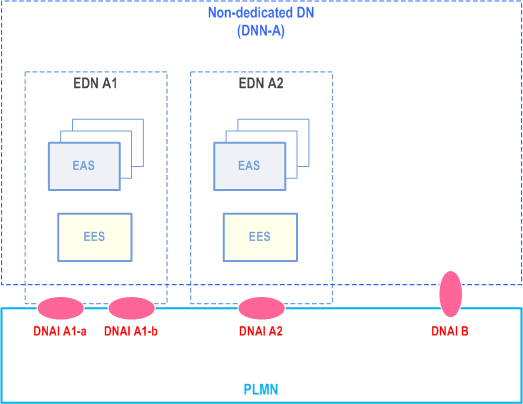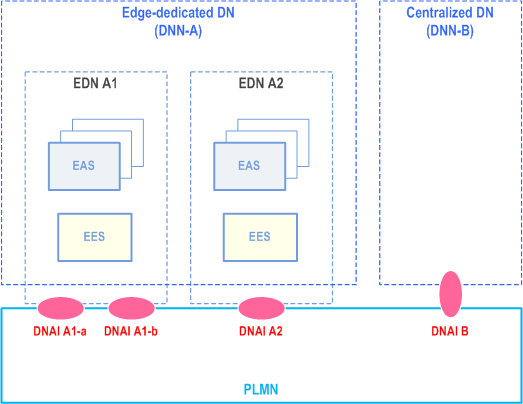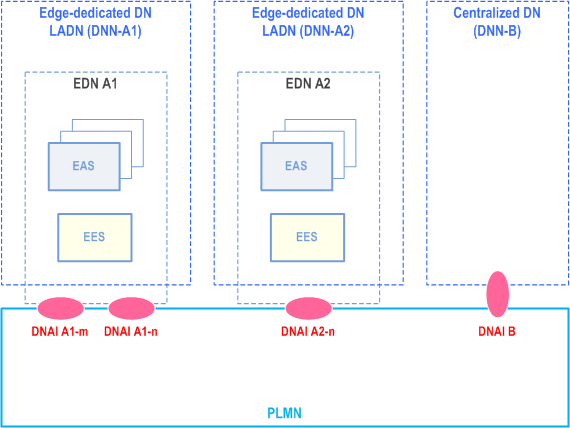Content for TS 23.558 Word version: 19.2.0
0…
5…
6…
6.2a…
6.2b…
6.3…
6.4…
7…
8…
8.3…
8.3.3…
8.3.3.3…
8.4…
8.4.3…
8.4.4…
8.5…
8.6…
8.6.3…
8.6.4…
8.6.6…
8.7…
8.8…
8.8.2.5…
8.8.2A…
8.8.3…
8.8.4…
8.8.5…
8.9…
8.14…
8.14.3…
8.15…
8.17…
8.17.3…
8.17.4…
8.18…
8.19…
8.20…
9…
A…
A.4…
A.5…
B…
E…
A Deployment models
A.1 General
A.2 Deployment models for different DN implementations
A.2.1 General
A.2.2 Option 1. Use of non-dedicated DN
A.2.3 Option 2. Use of Edge-dedicated DN
A.2.4 Option 3. Use of LADN
A.3 ECS deployments in relation to the UE
A.3.1 General
A.3.2 UE (EEC) served by a single ECS
A.3.3 UE (EECs) served by multiple ECSs
...
...
A Deployment models p. 289
A.1 General p. 289
The following clauses illustrate different aspects of some possible deployment options
- Clause A.2 describes some deployment models for different DN implementations;
- Clause A.3 describes some options for how ECS is deployed in relation to the UE;
- Clause A.4 describes deployment of EES in relation with SEAL services and Application Enabler Services; and
- Clause A.5 describes deployments in relation with CAPIF.
A.2 Deployment models for different DN implementations p. 289
A.2.1 General p. 289
This clause describes examples of deployment models with respect to different DN implementations as follows:
- option 1: use of non-dedicated DN;
- option 2: use of Edge-dedicated DN; and
- option 3: use of LADN.
A.2.2 Option 1. Use of non-dedicated DN p. 289
There is no Edge-dedicated DN for support of edge computing service. A DN common to other services (e.g. internet access) is used to connect to the EASs.
The PLMN supporting edge computing services provides connection to EASs located in EDNs that respectively corresponds to one or more DNAI(s), and each EDN is identified by DNN and one or more DNAI. UEs establishing PDU sessions for the EASs identify the DN using the same DNN and slice information as for PDU sessions for non-Edge services.
Each EAS and EES can have a topological service area or a geographical service area that the EAS and EES serves, respectively. Within this service area, UEs can access an EAS or an EES regardless of their location within the PLMN area via local breakout.

A.2.3 Option 2. Use of Edge-dedicated DN p. 290
The deployment uses Edge-dedicated DNs for support of edge computing service. Each Edge-dedicated DN is configured with unique DNNs.
The PLMN supporting edge computing services provides connection to several EDNs that correspond to one or more DNAI(s), and each EDN is identified by DNN of the Edge-dedicated DN and one or more DNAI.

A.2.4 Option 3. Use of LADN p. 290
Edge computing services can be provided via Edge-dedicated Data Networks deployed as LADNs. With this option, the PLMN supports edge computing services in the EDN service areas which is equal to the LADN service area. The LADN service area is the service area that the Edge Computing is supported. Each individual EAS in the LADN can support the same or smaller service area than the LADN.

A.3 ECS deployments in relation to the UE p. 291
A.3.1 General p. 291
This clause shows some examples for how the ECS can be deployed in relation to the UE
A.3.2 UE (EEC) served by a single ECS p. 291
In this scenario the UE can contain a single AC or multiple ACs, however the UE contains a single EEC which is configured with the address of a single ECS. This could for example be an IoT device that only supports a single AC or a smartphone device which contains many ACs which are served by a single ECS.
A.3.3 UE (EECs) served by multiple ECSs p. 291
In this scenario the user is allowed to install multiple ACs in the UE where each AC can be served by an EAS which in turn served by a different ECSP's EES/ECS.
One example is that multiple ACs are installed on a smartphone and the associated EASs are on-boarded onto different ECSP's EESs which are registered with different ECSs.
Another example is a UE that supports Dual SIM. In this scenario the UE can support concurrent connection to two PLMNs.